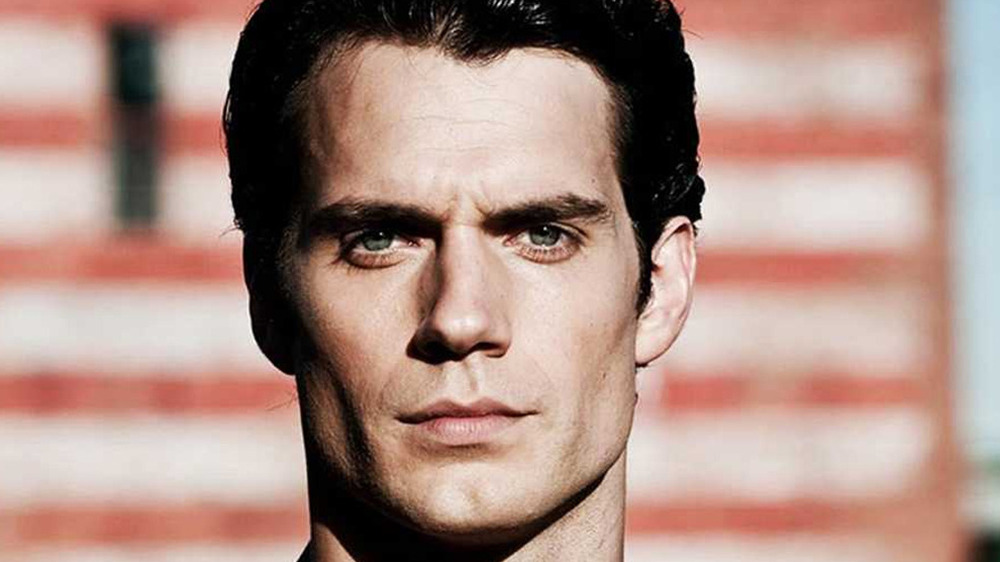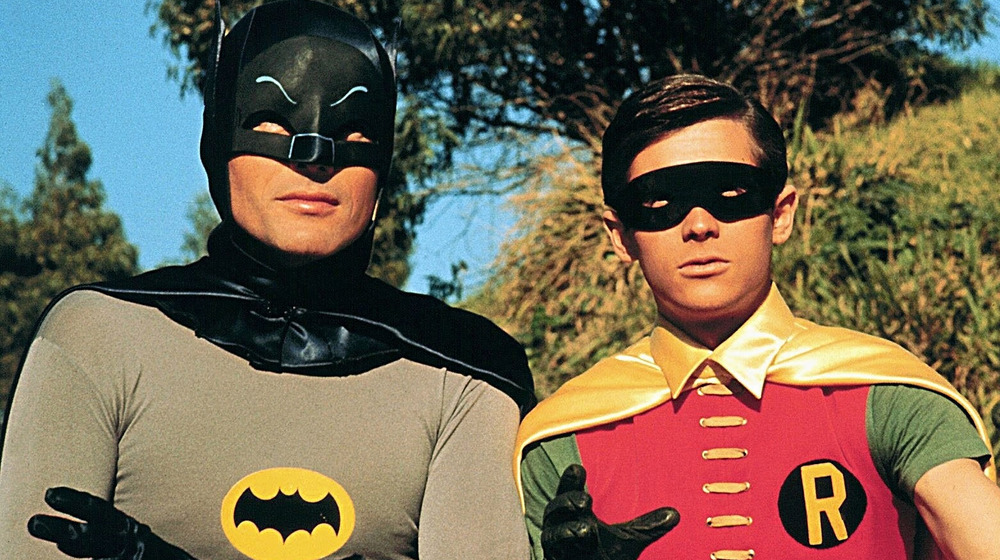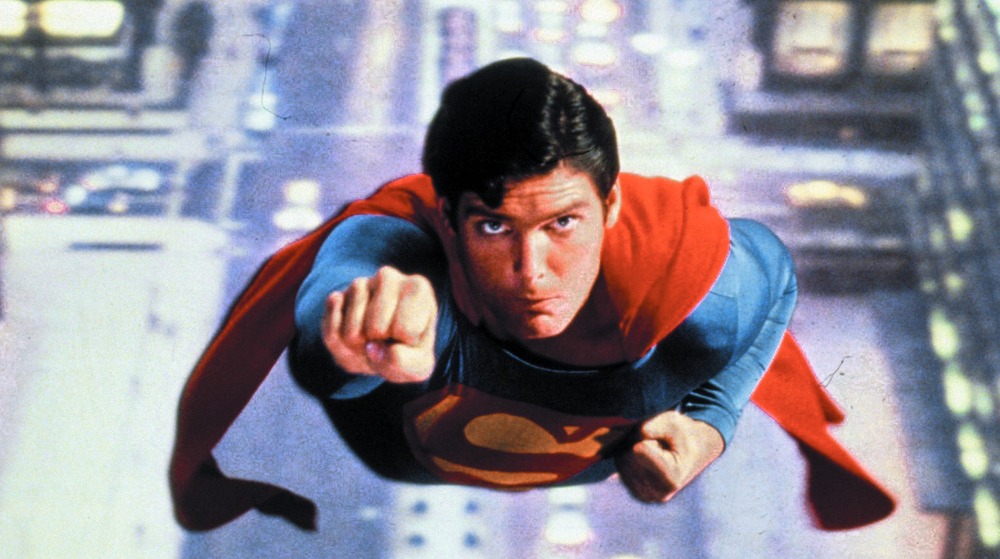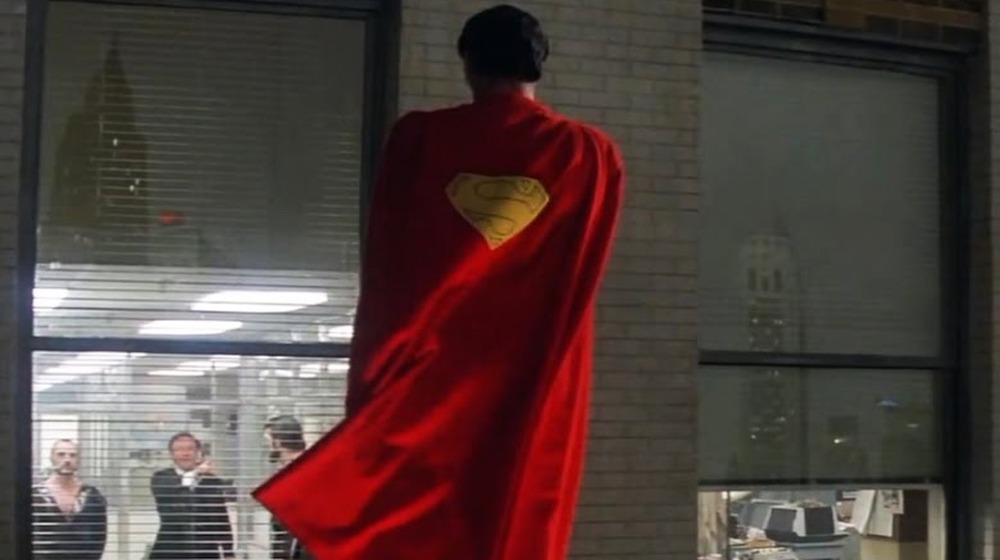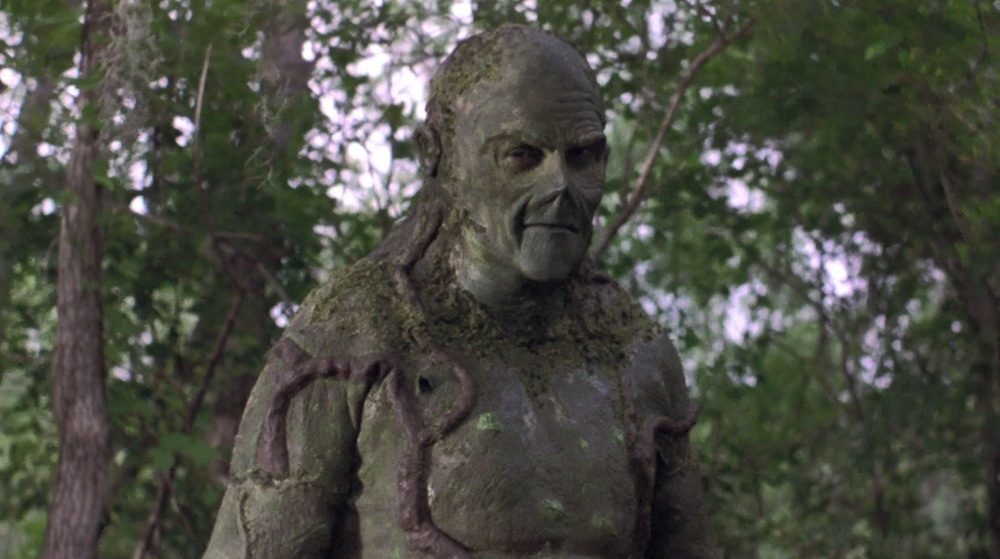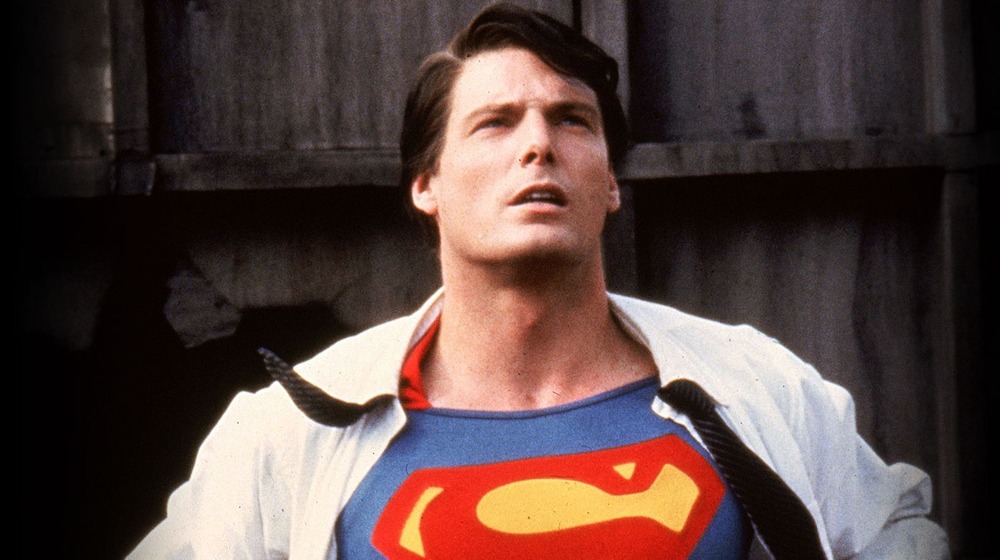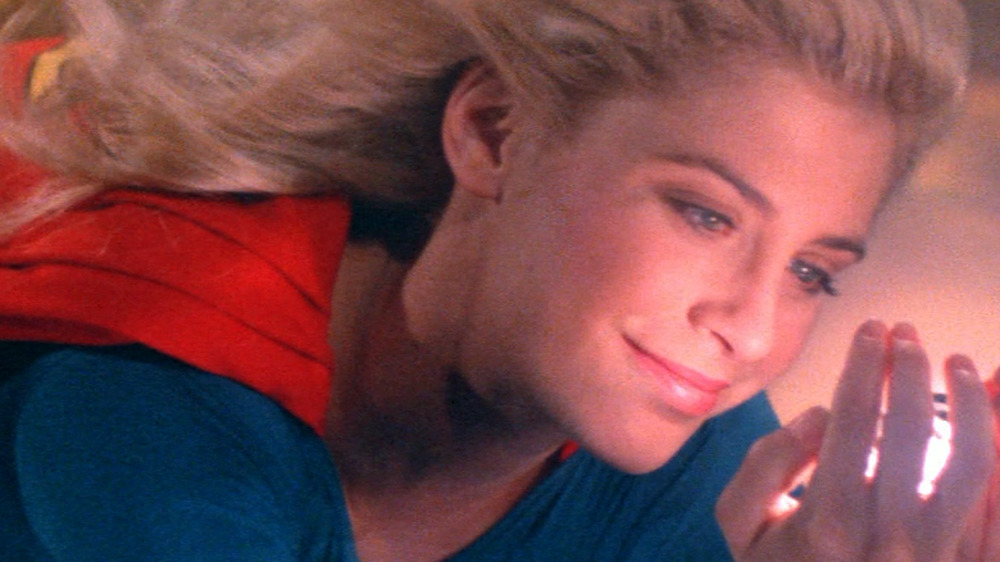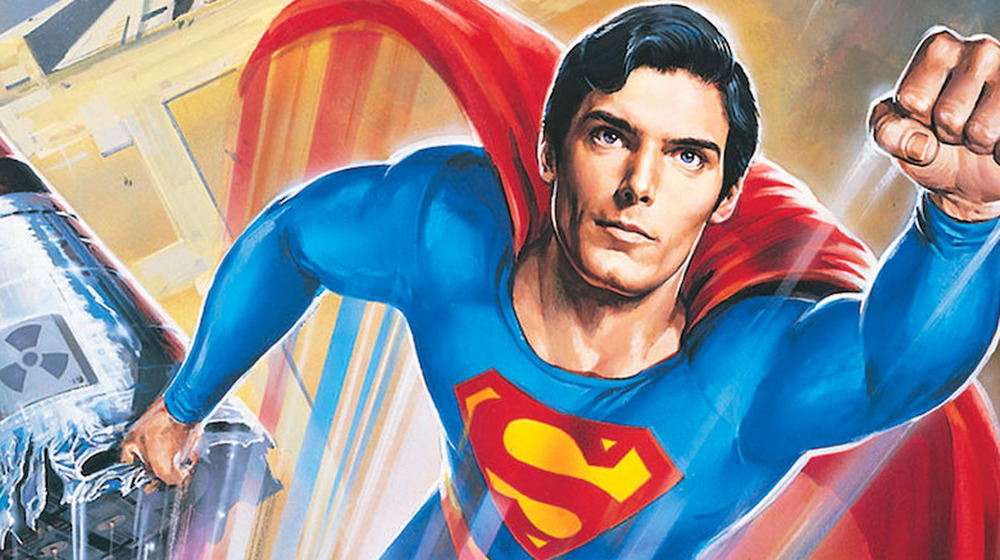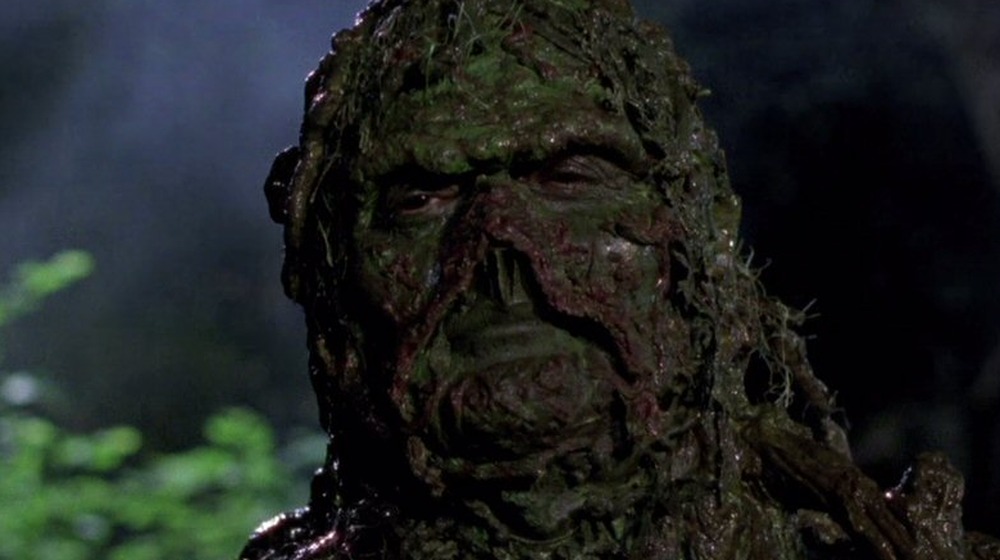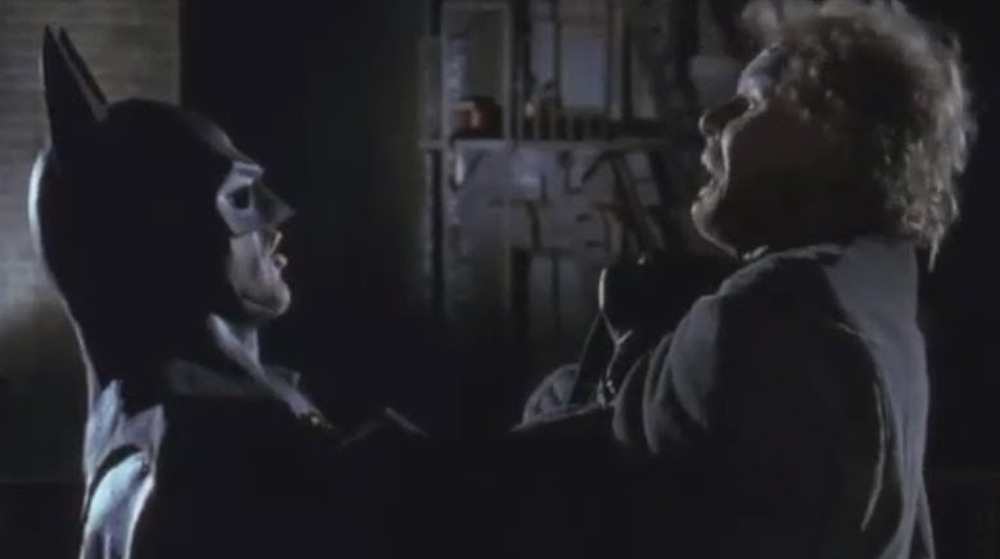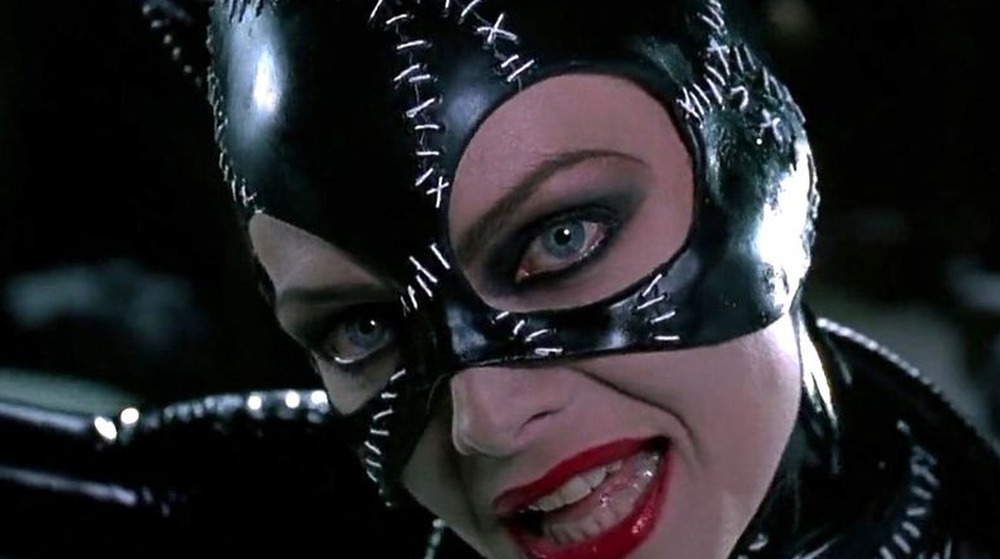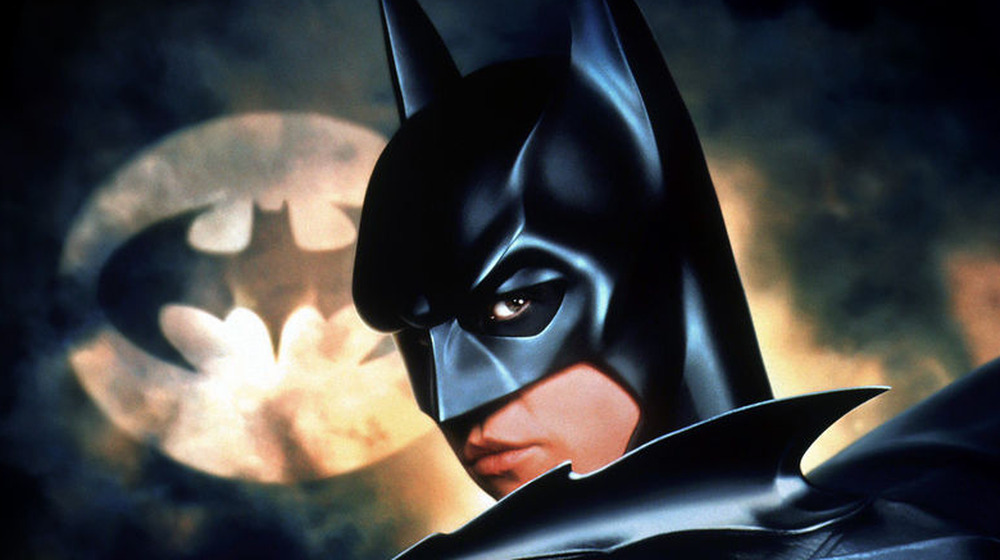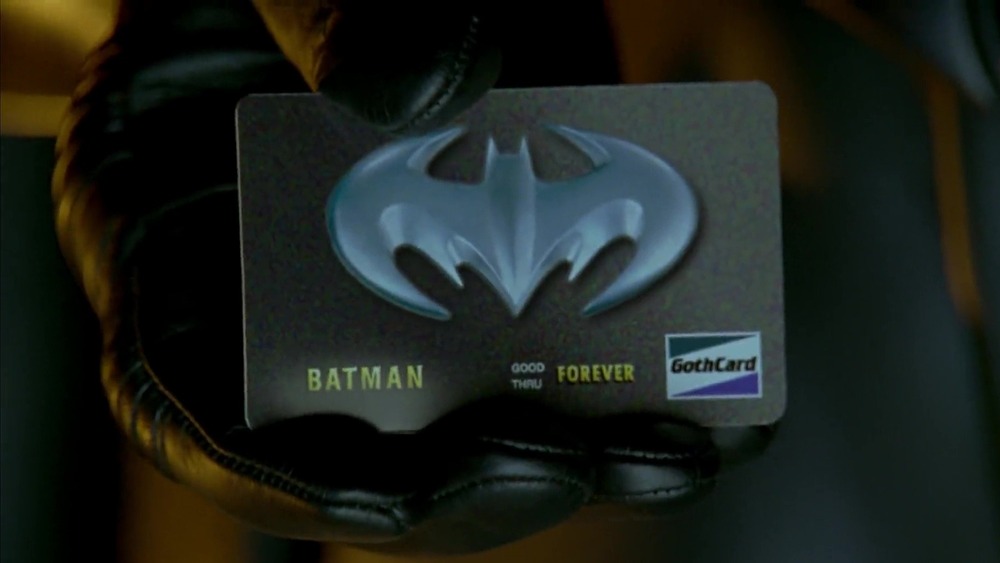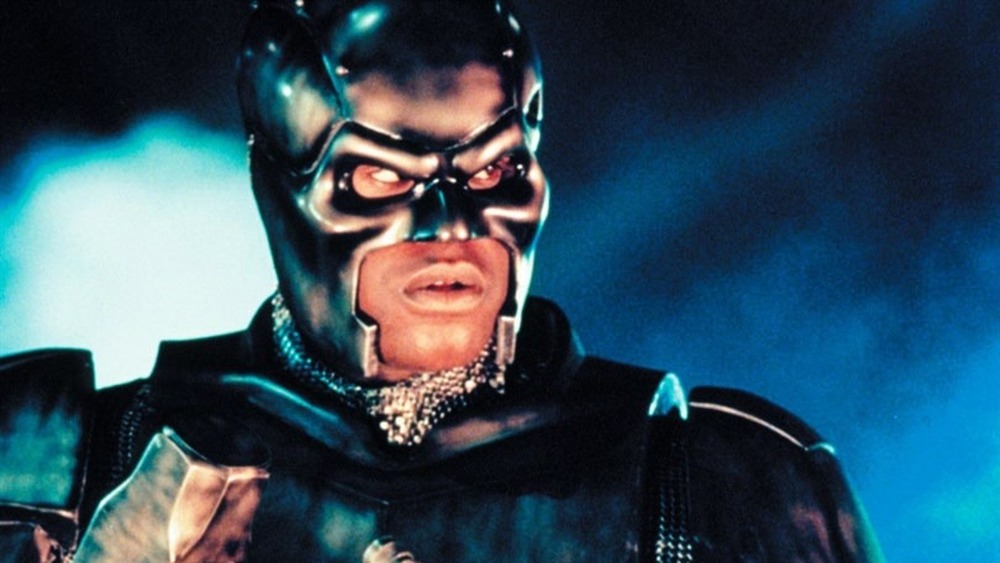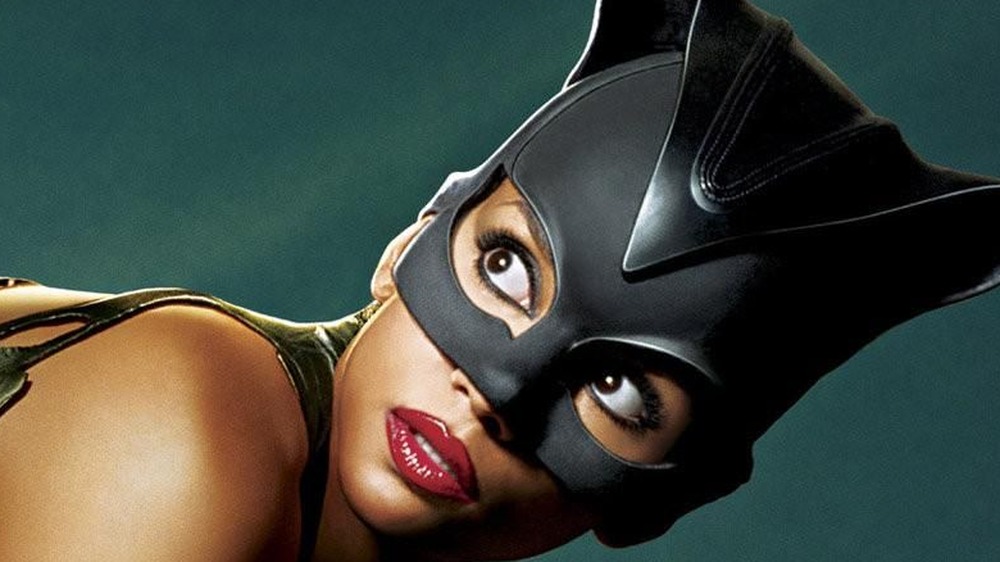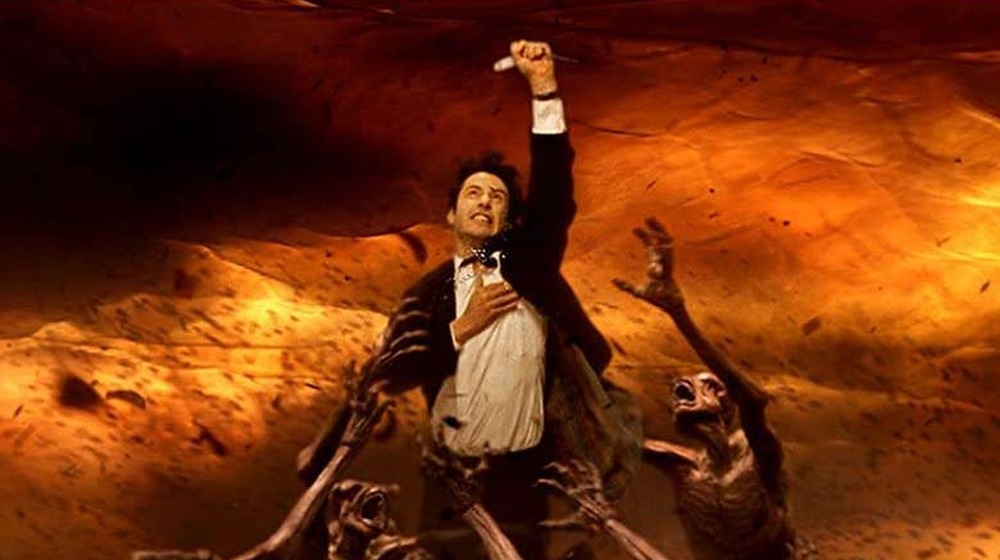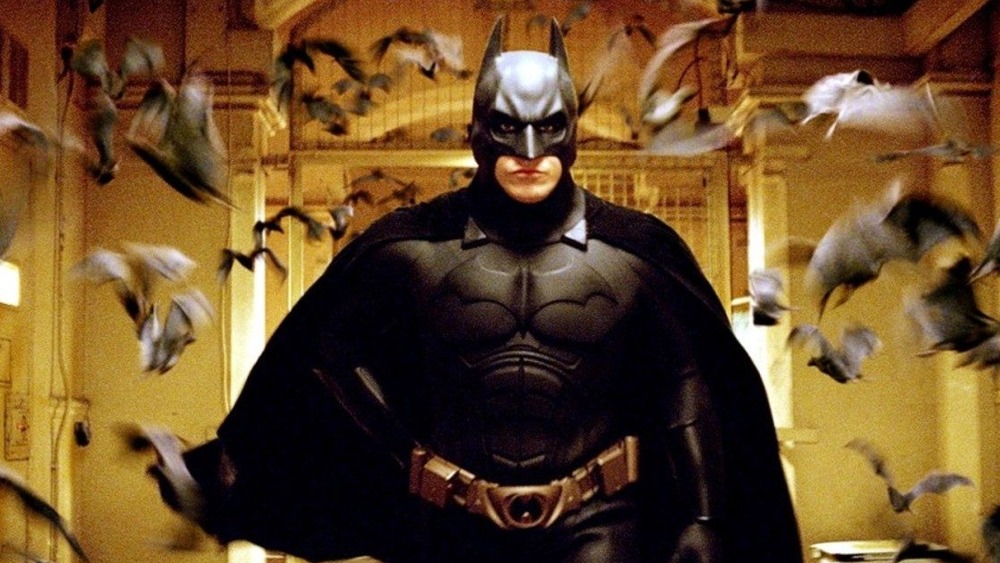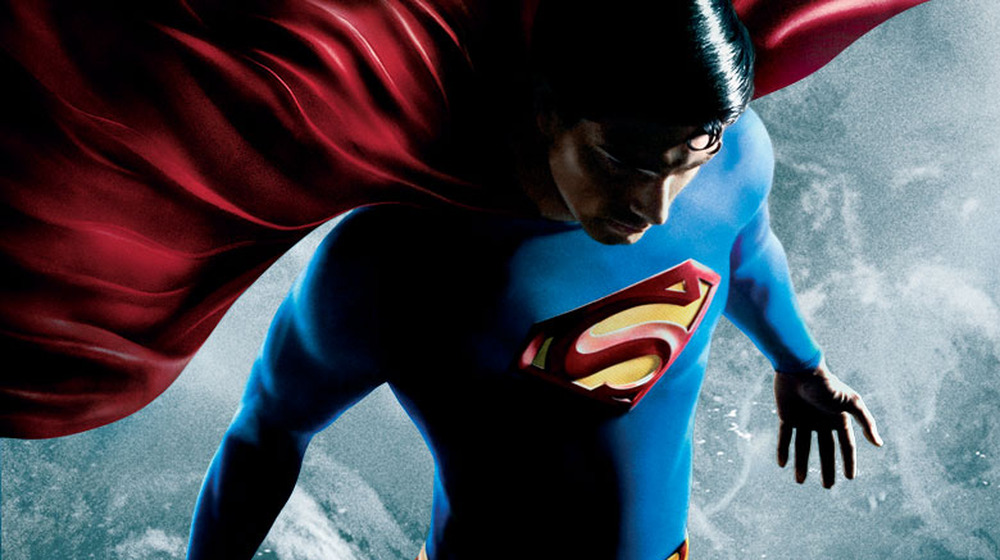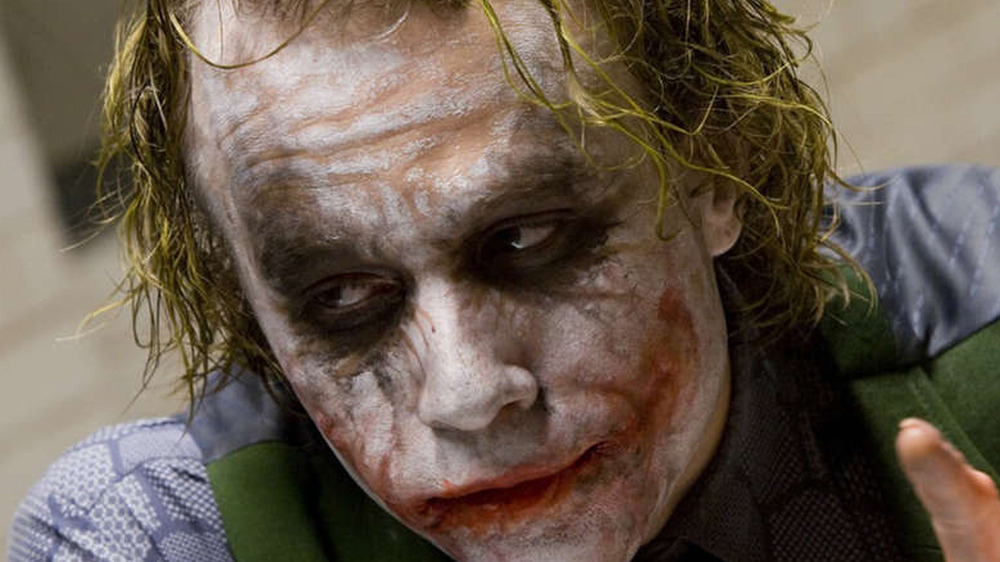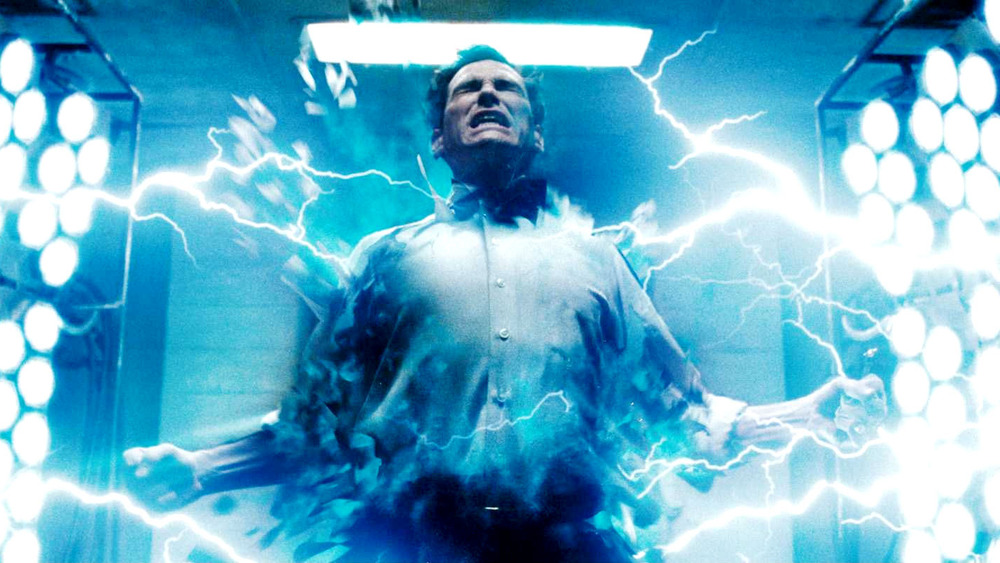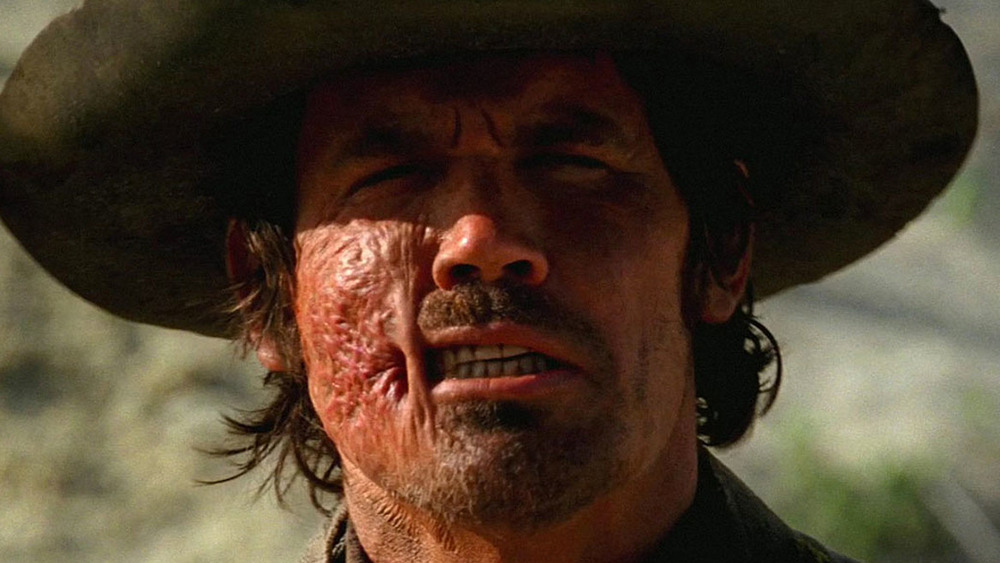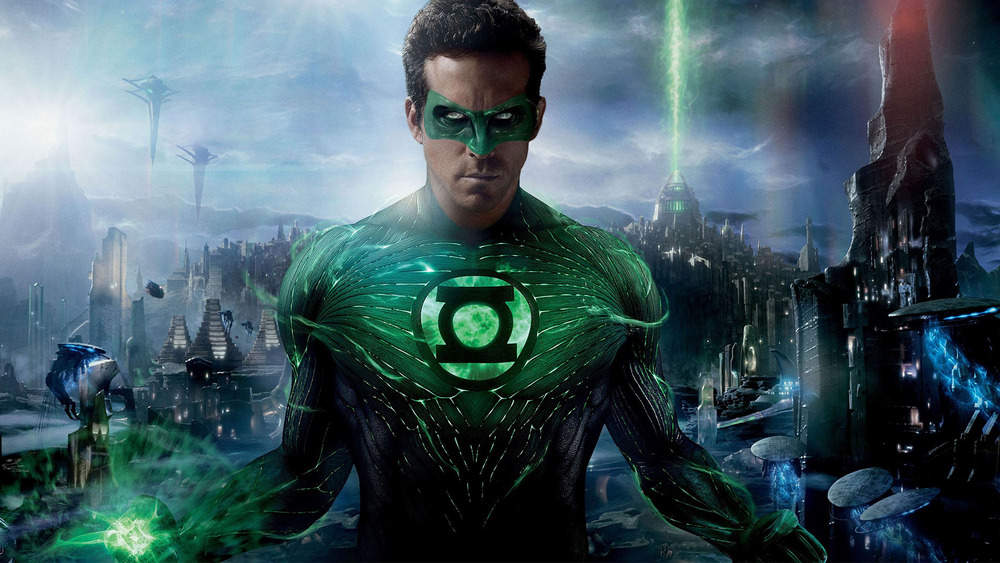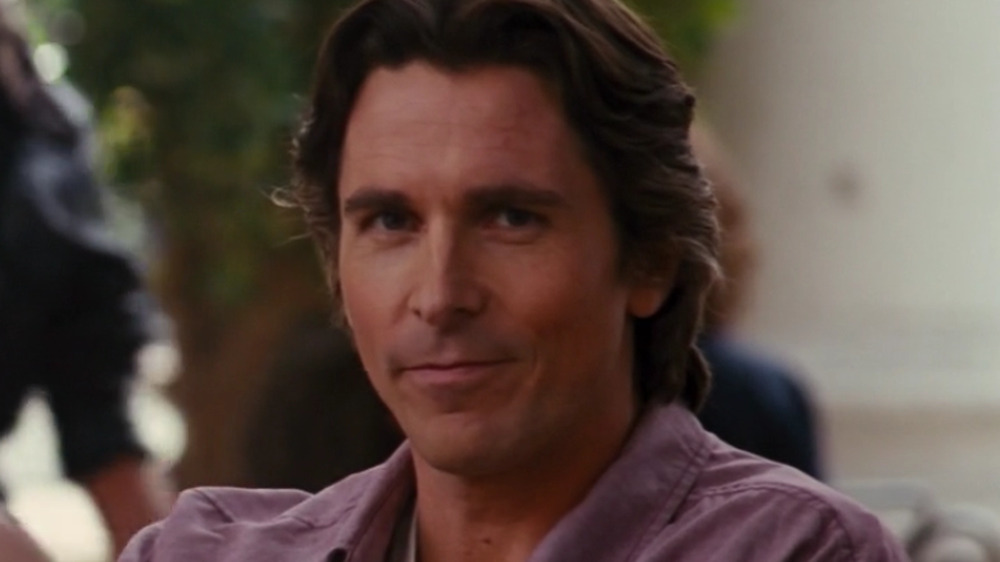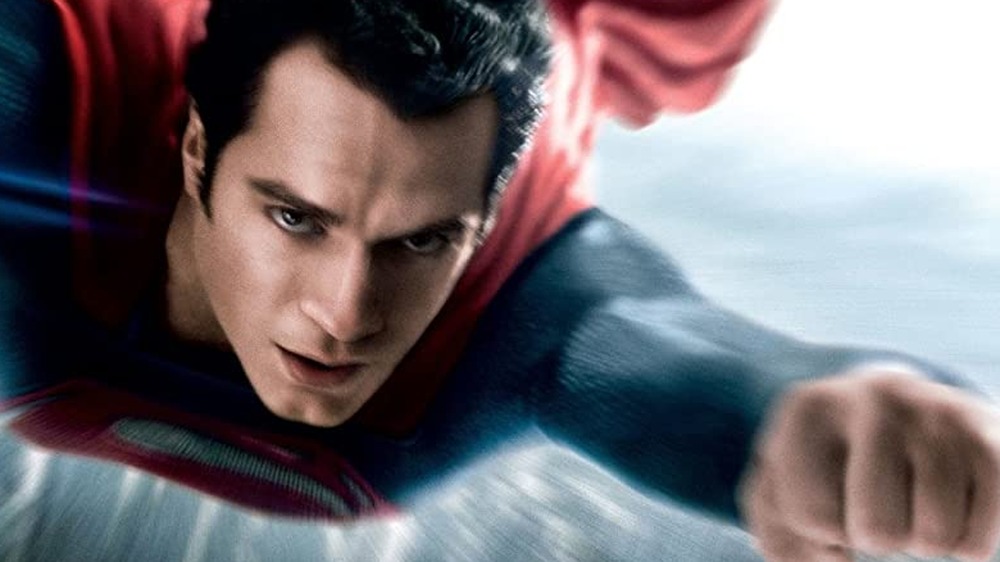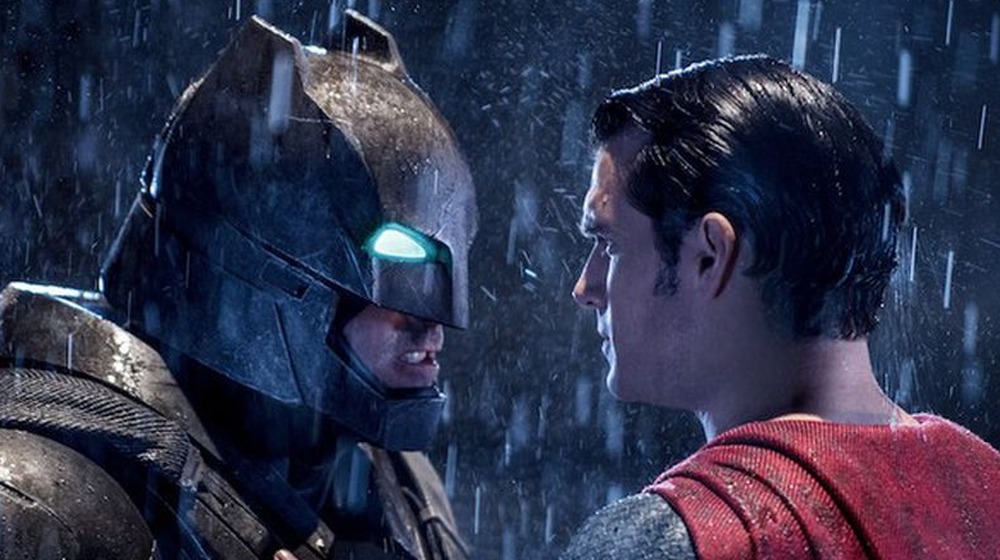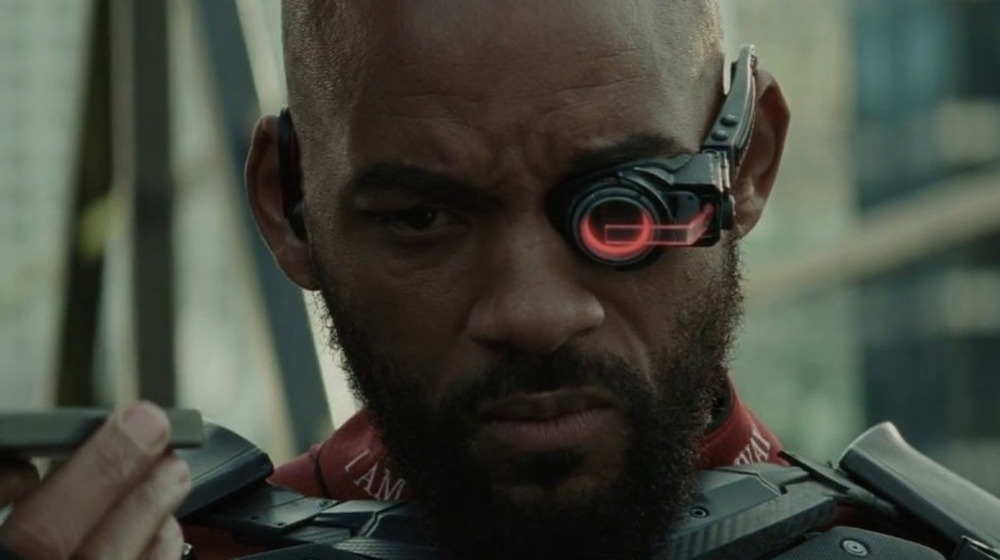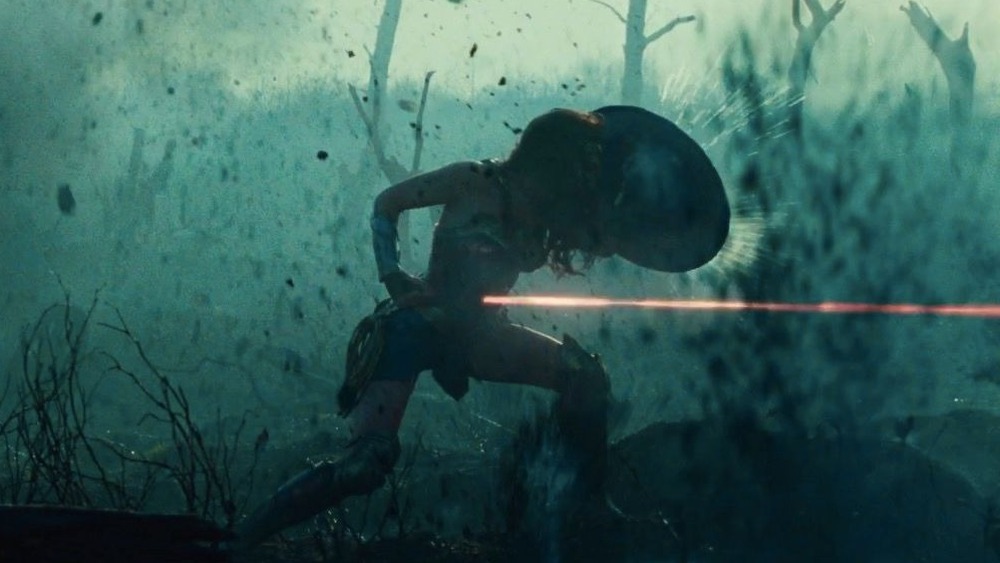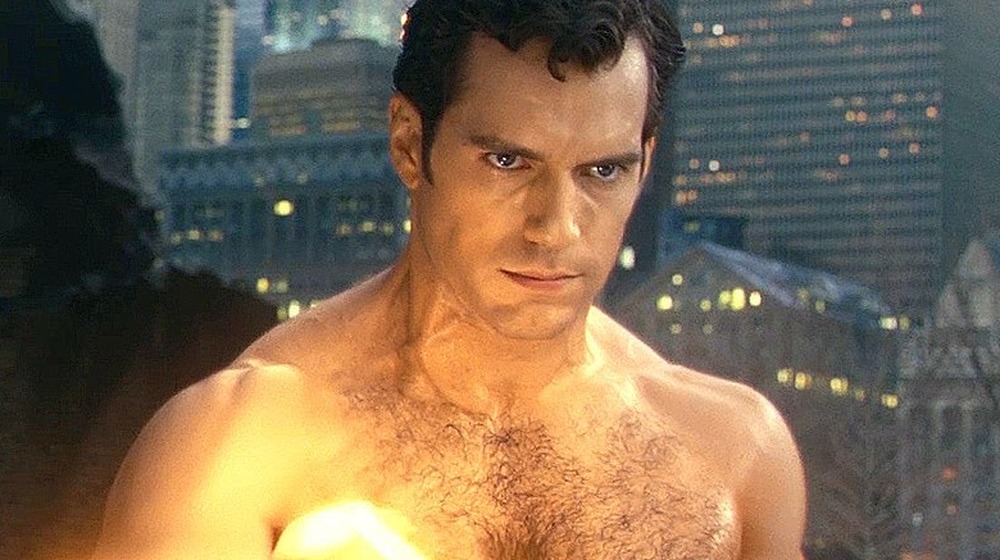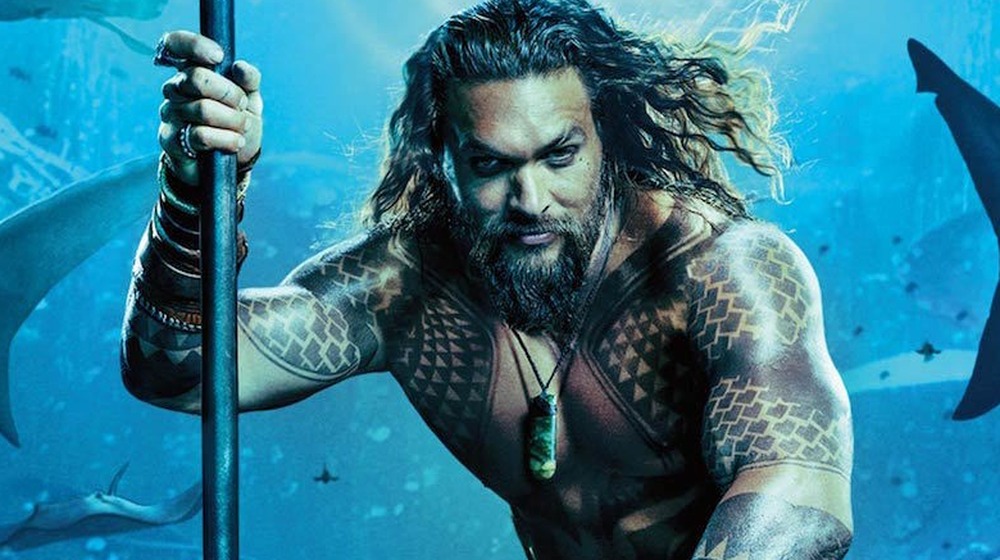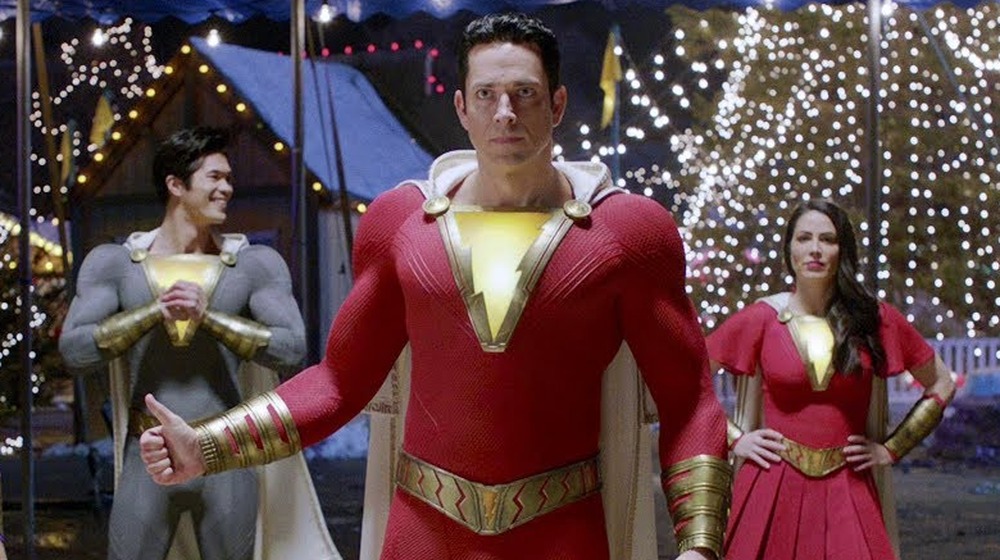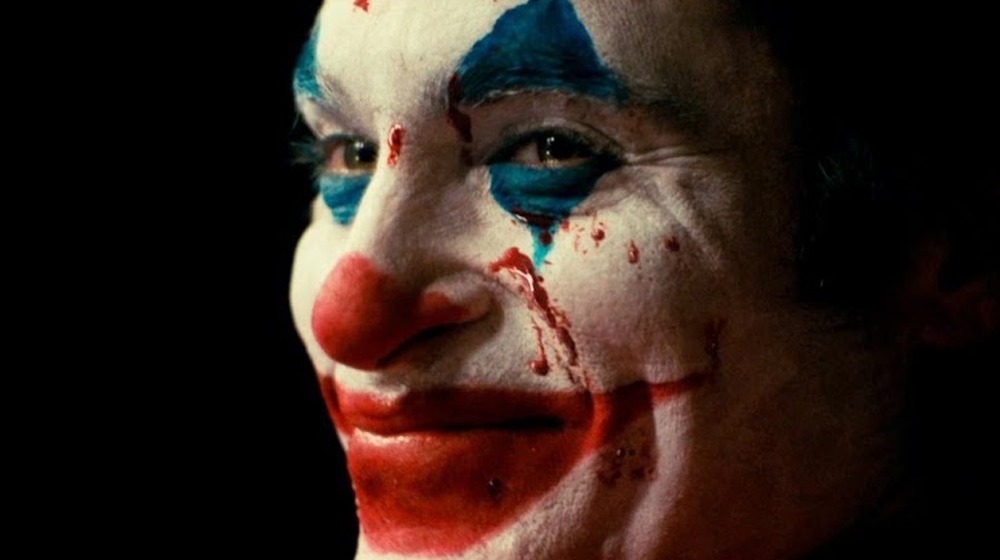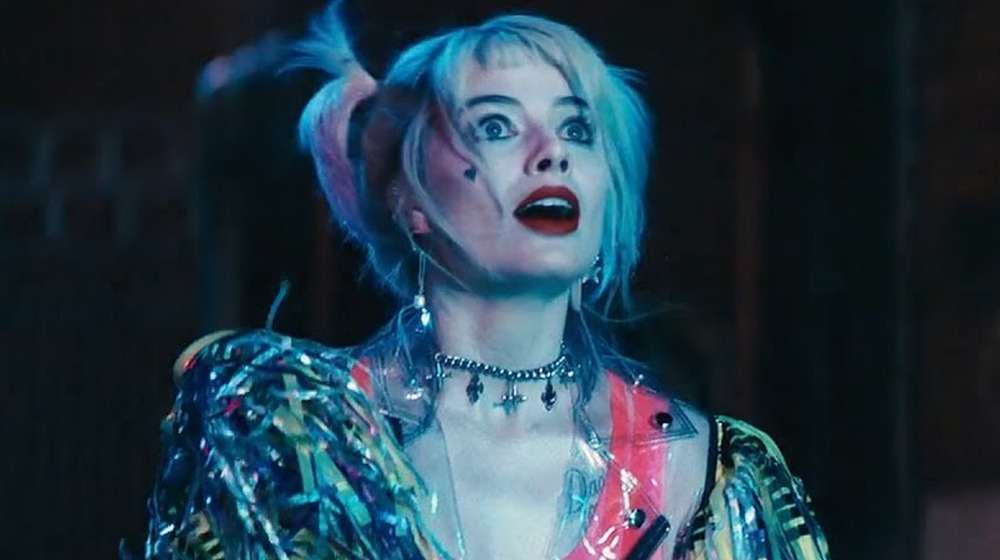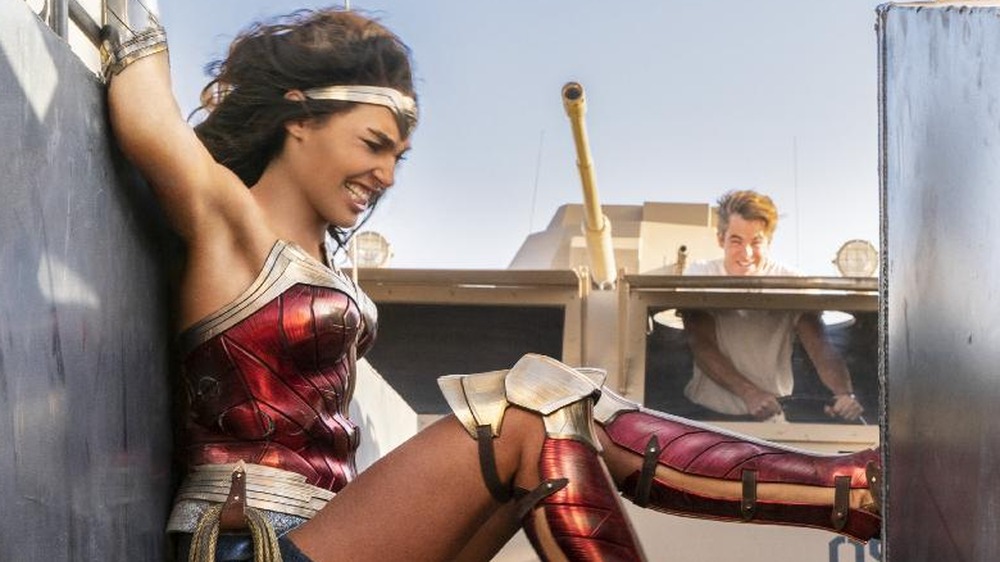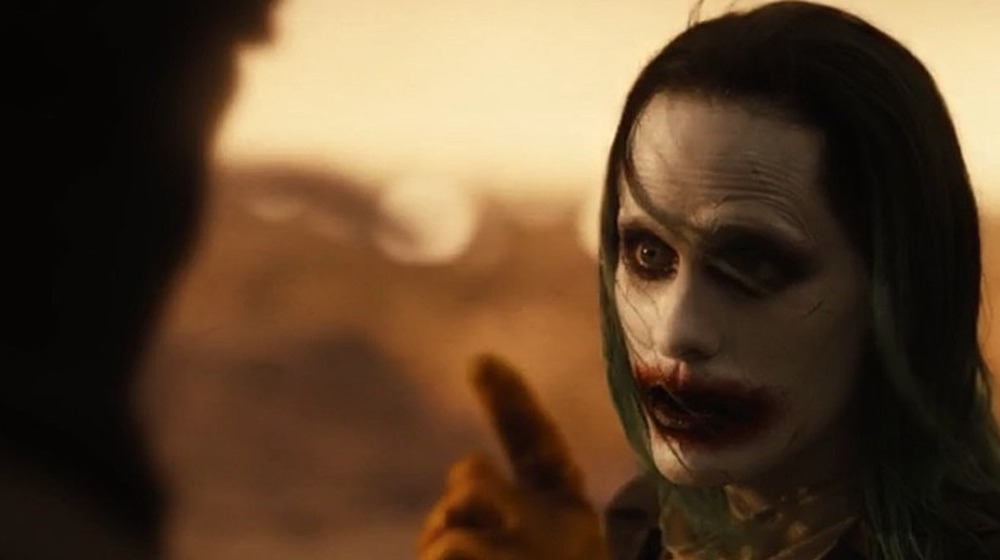The Most Iconic Scene From Every DC Movie
DC Comics' film history stretches back a long time. From the early Superman serials to the DC Extended Universe, these superheroic films have left a lasting impression on moviegoers all over the world. Some DC movies are regarded as cinematic art, others are remembered as escapist fun, and a few, unfortunately, are considered major embarrassments.
Good or bad, however, all of these films offer memorable moments that evoke strong responses from audiences. With this in mind, we've gathered what we consider to be the most iconic scenes from modern live-action DC movies. While it's difficult to offer a definitive list of classic moments, we feel these selections stand out as the most inspirational, shocking, or dramatic scenes of their respective movies. We're also presenting them in order of release, allowing you to see just how dramatically DC films have changed over the decades. From Wonder Woman's brave march across the battlefield to the Joker's interrogation room antics, these are the DC movie moments no one can forget.
Batman (1966): "Some days, you just can't get rid of a bomb!"
1966's Batman contains a scene that perfectly encapsulates the TV series' campy tone. Upon discovering a smoking bomb in the United Underworld's HQ, Batman (Adam West) dashes out of the building to dispose of it. Unfortunately, he runs into nuns, a woman with a baby carriage, and even a Salvation Army brass band, which prevent him from tossing the bomb away. Finally, he tries to throw it into the ocean ... but can't bring himself to do so when he sees a family of ducks in the water.
Cue Batman's famous lament: "Some days you just can't get rid of a bomb!" Batman dashes off screen, only for the bomb to explode a second later. Not to worry though -– ever resourceful, the Caped Crusader simply ducked behind some heavy lead pipes that shielded him from the blast.
Ridiculous and hilarious, this scene emphasizes that Batman would rather sacrifice himself than allow innocent people to get hurt. This might be one of the weirder Batmen out there, but no one can say that Adam West's "Bright Knight" isn't iconic in his own right.
Superman (1978): Superman reveals himself to the world
Considered to be a classic film in its own right, in addition to one of the greatest live-action Superman movies, Superman (1978) is one of the first DC films to truly take its hero seriously. This means lavishly depicting the planet Krypton, complete with Marlon Brando as Jor-El, as well as including an extended sequence of young Clark Kent's life in Smallville.
All of this provides many memorable scenes, but as the film nears the end of its first hour, most audiences are eager to see Superman make his debut. They aren't disappointed. Although the Man of Steel first appears in the Fortress of Solitude, he truly reveals himself to the world after a disastrous helicopter takeoff threatens the life of Lois Lane. Seeing he's needed, Clark Kent (Christopher Reeve) races across the street, rips open his shirt, and reveals the famous "S" emblem on his chest. After spinning through a revolving door, Superman takes to the sky where he catches Lois mid-fall before a crowd of shocked spectators.
Accompanied by John Williams' classic Superman score, this scene still sends chills down the spines of audiences today. Plenty of people have played Superman since Reeve, but this iconic moment set the standard for all future Superman transformations.
Superman II (1980): "General, would you care to step outside?"
Often seen as the best of the Alexander and Ilya Salkind Superman movies, Superman II sees Clark Kent sacrifice his powers to be with Lois Lane (Margot Kidder). Unfortunately, he does this just as some Kryptonian criminals led by General Zod (Terence Stamp) escape from the Phantom Zone. Realizing that only Superman can stop this threat, Clark manages to re-energize his powers at the Fortress of Solitude.
Back in Metropolis, Zod and his cohorts invade the Daily Planet and threaten to kill everyone in the building unless the "son of Jor-El" appears. Just as all hope seems lost, a powerful gust of wind blows over some newspapers announcing the White House's surrender, the music swells, and a familiar caped figure soars in front of the Daily Planet's windows. "General," Superman states calmly. "Would you care to step outside?"
What follows is a massive clash between Superman and the three super-criminals. Superman is known for his dramatic entrances and last-second arrivals, and this moment definitely shows why.
Swamp Thing (1982): Swamp Thing vs. Anton Arcane
The first Swamp Thing movie was released when comic book films were still trying to strike a balance between serious storytelling and campy comedy. Thus, the main character comes across as a classic B-movie monster, albeit one of a more heroic variety. When Dr. Alec Holland (Ray Wise) is burned alive by Anton Arcane's (Louis Jourdan) henchmen, he transforms into the plant-like Swamp Thing (Dick Durock). Swamp Thing proceeds to battle Arcane after he uses Holland's serum to transform into a boar-like beast.
This is all a bit silly by modern standards. In fact, the final scene, where Swamp Thing fights Arcane in beastly form, is iconic for its sheer cheesiness. Both characters are obviously wearing rubber suits, and the bestial Arcane even uses a sword against his regenerating opponent. Later productions, like 2019's Swamp Thing TV series, emphasize the serious aspects of Swamp Thing, and offer better special effects. In contrast, this film is just goofy fun — but sometimes, that's memorable in its own way.
Superman III (1983): Clark Kent vs. Superman
Despite its reputation as one of the weaker entries in the Superman movie franchise, Superman III contains one of the most iconic scenes in Superman movie history: The eerie sequence in which Clark Kent battles Superman. After Gus Gorman (Richard Pryor) creates a synthetic form of Kryptonite, he exposes Superman to the toxic substance, which brings out a mean streak in the Man of Steel. Eventually, the effects of the fake Kryptonite split the former hero into two beings: A good Clark Kent and an evil Superman.
The two come to blows in a junkyard, where Superman tries to destroy his nerdy alter ego by burying him under an electromagnet and crushing him in a trash compactor. However, Clark refuses to succumb, and finally strangles his corrupt counterpart, causing the evil Superman to vanish. In the aftermath, Clark rips open his shirt, showing the bright "S" shield, and soars away as Superman reborn. It's a great sequence that really shows how well Christopher Reeve embodied both Superman and Clark Kent.
Supergirl (1984): Arrival on Earth
Though it proved to be a failed attempt to expand the Superman movie franchise, Supergirl still offers a memorable performance by Helen Slater as Supergirl, AKA Kara Zor-El. She truly shines in a great scene showing her arrival on Earth. Raised in the sterile world of Argo City, Kara has never seen trees or plants. When she journeys to Earth, she discovers both the wonders of the natural world and her new superpowers.
Slater displays an innocent wonder as she picks up a rock and accidentally crushes it in her hand. She plucks a flower, makes it bloom with her heat vision, and is shocked and delighted when she finds herself floating. As she grows more comfortable somersaulting through the air, Supergirl takes her first proper flight. She soars through the clouds and follows a herd of wild horses before landing on a beach to watch the sunset.
While the rest of the film doesn't measure up, this iconic scene helps distinguish Supergirl from Superman. Where Clark Kent had time to grow accustomed to his powers, since he had them as a child, Kara receives all of her powers as a teenager. Watching her discover them is a wonderful experience.
Superman IV (1987): Superman vs. Nuclear Man
Although it's generally seen as the worst Superman movie, one sequence in Superman IV stands out: The battle between Superman and his solar-powered clone, Nuclear Man (Mark Pillow). Created by Lex Luthor to destroy the Man of Steel, Nuclear Man decides to first "have fun" by flying around the world and causing disasters. He smashes the Great Wall of China, activates missiles in Moscow, creates a tornado in Kansas, starts a volcanic eruption in Italy, and drops the Statue of Liberty onto New York.
Of course, Superman follows Nuclear Man and manages to set everything right –- although budget constraints and weak storytelling cause him to develop some strange new powers in the process (at one point, he rebuilds the Great Wall of China by shooting lasers from his eyes). Despite the poor special effects, it's actually a lot of fun seeing Nuclear Man wreak havoc on famous world landmarks. The scene manages to be both memorable and silly.
The Return of Swamp Thing (1989): Swamp Thing poses for a photo
By 1989, Swamp Thing had undergone a revival in DC comics, thanks to superstar writer Alan Moore's reconfiguration of the character. The Return of Swamp Thing largely ignores these changes, opting instead to lean into B-movie comedy. Dick Durock reprises his role as Swamp Thing (this time in grosser makeup), but displays a more casual attitude as he beats up several new monsters, including one who needs to use an asthma inhaler. He also gets a new love interest in Abby Arcane (Heather Locklear).
One particularly funny scene unfolds when a baseball bat-wielding Swamp Thing saves a couple kids from a monster. When the kids try to take a photo of him for the tabloids, Swamp Thing not only obliges, he has one of the kids pose with him in the shot. If only Bigfoot was as accommodating.
Batman (1989): "I'm Batman."
Tim Burton's 1989 film Batman set a new tone for live-action depictions of the Dark Knight. No longer the campy crimefighter of the 1960s TV show, Batman (Michael Keaton) could now be portrayed as the brooding, serious hero of the comic books. Nowhere is this more on display than in Batman's first appearance, in which he steps out of the shadows to brutally take down two muggers. As he drags one of the thugs to the edge of a building, the terrified man manages to gasp, "What are you?" "I'm Batman," the Dark Knight replies, before stepping off the ledge and vanishing.
With these two deceptively simple words, Keaton established a new precedent for the character. This iconic line has been repeated in practically every Batman film and TV series that has followed, as it effectively communicates everything you need to know about the Dark Knight. He's Batman — no detail needed. We all know what that means, because Keaton made it clear the first time around.
Batman Returns (1992): "I am Catwoman. Hear me roar."
One thing about Tim Burton's Batman movies? The villains almost always overshadow the hero. Nowhere is this more obvious than in Batman Returns: Even Batman co-creator Bob Kane admitted, "I think Catwoman stole the show."
Michelle Pfeiffer's Selina Kyle goes through a dramatic character arc in the film, starting out as a humble secretary to her corrupt boss Max Shreck (Christopher Walken). After he pushes her out of a window, Selina is revived by a colony of cats, and transforms into a more aggressive version of herself, with her own ideas about justice.
Her first big action scene establishes exactly who this Catwoman is. When she sees a mugger assault a young woman, Catwoman brutally kicks the thug into submission, clawing his face into a bloody pulp for good measure. But then, she assaults the would-be victim and berates her for waiting for a (Bat)man to save her. "I am Catwoman," the anti-heroine purrs, putting her own spin on "I Am Woman," Helen Reddy's 1971 hit, "hear me roar."
Batman Forever (1995): Suit up
Say what you will about the Joel Schumacher Batman films, but they have a distinctive style all their own. Granted, this style involves loud colors, outlandish costumes, and street gangs that like to wear neon face paint, but there's undoubtedly something admirable about the brazen way these films commit to the director's unique vision.
Batman Forever sets the tone in its opening scene, where we see Bruce Wayne (Val Kilmer) don his Batsuit (now complete with bat-nipples) and select his weapons. The scene proves to be so iconic that the film later parodies it, when Bruce dons a new prototype suit and gives the audience a close-up of his now-infamous "Bat butt." The sequence is also repeated in the sequel, Batman & Robin. Generally speaking, however, in later movies, the Dark Knight suits up in private.
Batman & Robin (1997): "Never leave the cave without it."
Batman & Robin is a movie that seems dead-set on one-upping itself with increasingly ridiculous scenes. One scene, however, elevates the silliness to unbelievable levels. While appearing at a charity benefit auction, Batman (George Clooney) and Robin (Chris O'Donnell) get exposed to pheromone-laden love dust, courtesy of Poison Ivy (Uma Thurman). They proceed to bid against each other for the right to date the villainess. To place the winning bid, the Dark Knight whips out his Bat-credit card, and informs the Boy Wonder, "[I] never leave the cave without it."
The infamous scene invites plenty of speculation among fans. Does Batman keep a secret bank account that can't be traced back to Bruce Wayne, for when he needs to make financial transactions? What exactly is his credit limit? Considering Batman is able to bid millions on Poison Ivy with his "GothCard" (which has an expiration date of "Forever"), this scene hilariously emphasizes the Dark Knight's true superpower: his wealth.
Steel (1997): Sparks shows off her upgrades
In the comics, Steel is John Henry Irons, a weapons designer who builds an armored suit to honor Superman when the Man of Steel (temporarily) dies fighting Doomsday. The movie version, however, simply has John Henry (Shaquille O'Neal) and his wheelchair-using partner Susan Sparks (Annabeth Gish) build the suit to take down a weapons dealer (Judd Nelson). The two wind up becoming a Batman-and-Oracle-type team that fights street crime.
In the film's climax, Burke's thugs capture Sparks. But as she quickly shows, she's installed a few surprises in her chair, including rockets and machine guns that let her take down the bad guys herself. As the crooks' warehouse catches fire, Sparks decides to make a quick getaway by activating some booster rockets in her wheelchair -– although she continues to move at regular speed. While the film was largely panned, this scene is surprisingly memorable for its sheer ridiculousness.
Catwoman (2004): Basketball
The 2004 Catwoman movie starring Halle Berry as the titular anti-heroine has been widely criticized for its nonsensical plot, bad acting, and poor special effects. Given that the film was nominated for seven Golden Raspberry Awards (and won four of them, which Halle Berry, ever the good sport, picked up in person), it won't surprise you to learn that the movie's most iconic scene isn't a great one.
The scene in question is the massively panned basketball scrimmage between Patience (Berry) and her love interest, Detective Tom Lone (Benjamin Bratt). After being challenged to a one-on-one basketball game by some kids, Patience uses her cat-like coordination and agility to flirt with Lone, eventually dunking the ball from the free-throw line. It's a silly, weirdly edited scene that's been thoroughly ridiculed — yet it remains unforgettable because of its flaws. Does that count as success? Not really ... but it sure is memorable.
Constantine (2005): Constantine descends into Hell
When Keanu Reeves was cast as DC's chain-smoking, magic-wielding anti-hero in Constantine, fans were confused: He seemed to be a far cry from the British street magician featured in DC's Hellblazer comic. Yet the film has gone on to gain a bit of a cult following.
The movie certainly contains more than a few memorable scenes. One of the best comes when Constantine attempts to discover whether or not a detective's twin sister (Rachel Weisz) committed suicide by going to Hell and looking for her there. After using a black cat to briefly transport himself to the other side, he sees the woman in question, eternally condemned to relive her suicide. Needing proof, he braves an army of demons to snatch her hospital wristband, and takes it back to her sister.
The image of Constantine reaching upward for the wristband as devils attempt to drag him down to Hell is an iconic moment that perfectly symbolizes his struggle to rise above his many demons. Reeves might not be the obvious choice for John Constantine, but he does embody the role in his own way.
Batman Begins (2005): Bruce Wayne embraces his worst fear
Batman Begins is significant — not only because it kickstarts the Dark Knight trilogy, but because it really is the first Batman film that's truly about Batman. Offering an in-depth look at the childhood trauma that shapes Bruce Wayne (Christian Bale), the movie spends much of its runtime showing Bruce training, growing, and researching before he finally reveals himself as Batman.
An earlier moment, however, stands out as the film's most iconic scene. At the start of the film, a young Bruce Wayne falls into a cave and develops a fear of bats after they attack him en masse. This phobia causes him to make his parents leave a performance of Mefistolfele, after the bat-like costumes of the performers scare him. When this causes his parents to encounter a mugger who kills them both, Bruce's guilt and anger drive him to master his fear by training with terrorist leader Ra's al Ghul (Liam Neeson).
Upon returning to Gotham City, an adult Bruce descends into the cave and is once again attacked by bats. This time, however, Bruce remains calm and lets the bats circle him, immersing himself in his worst fear. He might not be wearing the suit yet, but in that moment, Bruce Wayne truly becomes Batman.
Superman Returns (2006): Superman listens to the world
Visually stunning, Bryan Singer's Superman Returns is intended as a continuation of Christopher Reeve's Superman films, but was criticized for its somber depiction of the Man of Steel and the introduction of Superman's son, Jason. Brandon Routh's Superman was also criticized, although his brief return to the role in the CW's Crisis on Infinite Earths TV storyline drew praise.
Nevertheless, Singer makes sure to fill Superman Returns with plenty of amazing images of Superman displaying his god-like abilities. One particularly iconic scene occurs shortly after Superman's return, when he floats above the Earth and uses his super-hearing to listen to all the voices on the planet. As soon as he hears an alarm and some cries for help, he streaks downwards. Whatever his flaws, Superman is eternally Earth's greatest protector, and this scene demonstrates that in full.
The Dark Knight (2008): "You're just a freak ... like me."
Heath Ledger's disturbing yet magnetic performance as the anarchistic Joker earned him a posthumous Oscar for The Dark Knight. While virtually all of Ledger's scenes could be considered iconic, the interrogation scene between Batman and the Joker stands out as the most memorable.
After allowing himself to be caught by the cops, the Joker is placed in an interrogation room where he's questioned by Batman himself. Taking the opportunity to share his twisted perspective on society, Joker informs the Dark Knight that the moral code he lives by is "a bad joke" that civilization will abandon. Although Batman uses his most brutal tactics against the Joker, his efforts prove useless against his laughing foe, who flat-out tells him, "You have nothing ... nothing to threaten me with ... nothing to do with all your strength."
It's an upsetting scene, made even more disturbing by the fact that the Joker makes no effort to defend himself or even fight, yet still manages to get everything he wants. Even Batman can't score a definitive win against a foe like that.
Watchmen (2009): The birth of Doctor Manhattan
Some comic book films delight in putting their own spin on their source material. And then there's Zack Snyder's Watchmen (2009), in which practically every scene is directly lifted from the celebrated comic book. While there are differences between the comic and the movie, one iconic scene is especially faithful to the original work: The birth of Doctor Manhattan.
The only character with actual superpowers, Doctor Manhattan's creation is incredibly dramatic. After being accidentally locked in a test chamber, scientist Jon Osterman (Jaryd Heidrick) is literally torn apart by an experimental generator and left as a powerful, disembodied consciousness. Over the next few months, Jon learns to rebuild himself, re-appearing as a circulatory system, a partially muscled skeleton, and then, finally, as an omnipotent blue man –- America's own superman. Narrated by Billy Crudup's somber voice, the entire sequence is both haunting and riveting.
Jonah Hex (2010): "What happened to your face?"
Years before he made history as the MCU's Thanos, Josh Brolin portrayed one of DC's more obscure anti-heroes: Bounty hunter Jonah Hex. While the 2010 Jonah Hex film alters the character somewhat by giving him the mystical power of resurrecting the dead, it retains Hex's most distinctive feature — his scarred face.
In the movie, Hex receives his disfigurement after his Confederate commanding officer Quentin Turnbull (John Malkovich) brands Hex's face with his initials. Hex then removes the brand by intentionally scarring that half of his face. Later, a smart-mouthed thug asks what happened to his face while brandishing a knife. In response, Hex shoots him dead without getting up from his bar stool. "Cut myself shaving," the bounty hunter growls. "What happened to yours?"
Green Lantern (2011): Hal Jordan goes to Oa
Green Lantern is so thoroughly mocked, even its star Ryan Reynolds has taken a shot at it. In 2018's Deadpool 2, Deadpool travels back in time to shoot Reynolds, his own actor, before he can take the role of Hal Jordan.
Despite the film's problems, there is a standout scene in which Hal recites the Green Lantern Oath and gets propelled through a wormhole to Oa, the home planet of the Green Lantern Corps. Greeted by Green Lantern Tomar-Re, Hal finds himself in an advanced alien civilization. He flies over futuristic buildings, past the central Power Battery, and into an assembly of Lanterns, who let him know he's now part of something much bigger than himself.
Unfortunately, the rest of the film doesn't spend much time on Oa, choosing instead to focus on Hal's personal life. It's a shame, because the Green Lantern Corps really is the most fascinating aspect of Green Lantern.
The Dark Knight Rises (2012): Alfred sees Bruce Wayne for the last time
While most of Batman's most memorable movie scenes emphasize action and drama, The Dark Knight Rises offers an iconic scene that's deceptively low-key. After getting his spine broken by Bane, Bruce Wayne gradually rebuilds himself, escapes from prison, and returns to Gotham to save it from Bane's nuclear bomb -– seemingly at the cost of his own life.
But the movie isn't done with Bruce Wayne yet. In the film's final scenes, Bruce's butler Alfred Pennyworth (Michael Caine) takes a holiday to Italy and spies Bruce sitting at a nearby table with Selina Kyle, having finally let go of his vigilante lifestyle. The two men nod to each other and Alfred leaves, happy that his earlier fantasy of Bruce finding happiness outside Gotham has come true.
Unlike other Batman films that show the Dark Knight eternally locked into his crusade, Christopher Nolan's Dark Knight trilogy offers something new: closure. While some may argue that a symbol like Batman can never give up his role as Gotham's protector, The Dark Knight Rises establishes that, in at least one storyline, Bruce Wayne is able to get his happy ending.
Man of Steel (2013): Superman's first flight
Zack Snyder's Man of Steel is full of controversial choices. From the movie's grim tone to Superman's decision to snap General Zod's neck at the story's climax, this film divides fans with passionate intensity.
One scene, however, completely embraces the joy of being Superman. Upon discovering a Kryptonian scout ship in the Arctic, Clark Kent (Henry Cavill) receives his Kryptonian suit and steps into the sun to learn how to fly. As the disembodied voice of his father Jor-El (Russell Crowe) encourages him to "keep testing your limits," Clark progresses from super leaps to actual flight, soaring through clouds and canyons before reaching orbit. The look on Superman's face as he realizes what being a child of two worlds truly means is utterly heart-warming.
Batman v Superman (2016): The main fight
Superman's "Save Martha!" line from Batman v Superman has become a heavily-mocked Internet meme among superhero movie fans who find it, and Batman's furious reaction, completely out of place. Even so, many people enjoy Ben Affleck's take on Batman, particularly his intense workout scene, which shows just how hard it is to remain the Dark Knight.
Moreover, the film's main draw -– the fight between the Man of Steel and the Dark Knight -– doesn't disappoint. The movie sees an older Bruce Wayne employ everything from sonic cannons to Kryptonite gas to a heavily armored battle suit to gain an edge on his god-like opponent. And it works — although the two eventually stop fighting to team up, Batman definitely gets in multiple good hits against a man who's supposedly unbeatable.
Suicide Squad (2016): Deadshot kills everyone
While Suicide Squad received dire reviews from critics, many praised the action and Margot Robbie's performance as the maniacally delightful Harley Quinn. However, it's another character – Will Smith's Deadshot – who helms the most iconic scene in this film.
Recruited as part of a government-sponsored black ops team of supervillains, master assassin Deadshot is initially reluctant to participate, but finds himself thrust into the role of team leader. When his group ends up fighting an army of demonic monsters, Deadshot manages to convince the villains to fight alongside the military to survive.
Then, just as the demons threaten to overwhelm them, Deadshot steps up. He uses his uncanny aim and an arsenal of weaponry to take out every single demon, even as they get close enough to tear his head off. By the end of the film, Deadshot is still a villain, but he manages to earn the respect of even his hard-nosed military handler.
Wonder Woman (2017): Wonder Woman braves No Man's Land
Successfully depicting a live-action Wonder Woman comes with many challenges. Diana needs to walk the line between being a nurturing caregiver and a powerful warrior — not an easy balance to maintain. Patty Jenkins' Wonder Woman, however, contains an iconic scene that perfectly communicates exactly who Wonder Woman is and what she should be doing.
After accompanying Steve Trevor (Chris Pine) to Europe to help with World War I, Diana (Gal Gadot) finds herself at the war's front in Belgium. Seeing the suffering of soldiers and civilians breaks Diana's heart, and she insists on helping them. However, Steve claims making their way through the battlefield is impossible, as some of the men have been fighting for months and have barely gained an inch.
In response, Diana removes her cloak and marches onto the battlefield and across No Man's Land. Bullets and bombs try to cut her down, but the Amazonian princess doesn't relent, and leads the Allied forces to victory. It's a stunning action sequence that shows what an inspirational symbol of strength Wonder Woman can be.
Justice League (2017): Superman vs. the Justice League
The theatrically-released version of Justice League greatly alters Zack Snyder's original vision. What results is controversial among fans, who successfully lobbied for the release of Zack Snyder's Justice League in March 2021.
One scene, however, excites most fans: The fight scene between Superman and the Justice League. After being resurrected by an alien "Mother Box," the Man of Steel emerges from his tomb in an amnesiac state. When Cyborg (Ray Fisher) accidentally fires a blast at him, Superman attacks and shows just how powerful he is. The combined might of the Justice League can't restrain him: His super-speed even lets him keep up with the Flash (Ezra Miller). Most memorably, Batman finds himself on the receiving end of his own line when Superman asks him, "Do you bleed?"
Fortunately, Batman calls in Lois Lane (Amy Adams) just in time for her to reawaken Superman's humanity. He later returns as the League's ally — but everyone now knows you don't want to mess with the last son of Krypton.
Aquaman (2018): Calling all sea life
Despite the fact that he's one of DC's strongest heroes, Aquaman is ridiculed as being the guy who "talks to fish." Even Batman pokes fun at this ability in Justice League.
Aquaman changes this. Fully embracing the ridiculous and fantastic aspects of the character, the film immerses Aquaman (Jason Momoa) in an Atlantis bursting with underwater arenas and octopi drummers. There, he accepts a quest to recover a powerful trident that grants him control over all sea life.
What this means is revealed in the movie's climactic battle scene, when Aquaman arrives during an all-out war between undersea kingdoms. Drawing on his enhanced powers, Aquaman summons an army of sharks, whales, and sea monsters that completely overwhelms his opponents. It might sound like a silly power on paper, but people who see this scene know that "talking to fish" can be a devastating superpower.
Shazam! (2019): The kids all transform
At the heart of Shazam! (2019) is every kid's wish: To become a powerful superhero and not feel so overwhelmed by a world full of adults. The first half of the film tackles this dream with a lot of comedy, as 14-year-old Billy Batson (Asher Angel) gains the ability to transform into an adult superhero (Zachary Levi), allowing him to fly, fight bad guys ... and buy beer.
However, the film's best scene comes at the climax, when Billy stumbles onto a unique solution to stop the evil Dr. Sivana (Mark Strong) and his Seven Deadly Sins: He shares his power with his foster siblings. As the kids all shout "Shazam!," a bolt of lightning transforms them into colorful adult superheroes, ready to take on Sivana's army. While comic book fans might already be familiar with the Shazam family, the scene still manages to surprise and delight the audience in the best possible way.
Joker (2019): Joker's TV appearance
Joker manages to do what no other DC film does: It makes the Clown Prince of Crime into a sympathetic character. By introducing the Joker as lonely, abused Arthur Fleck (Joaquin Phoenix), audiences get to empathize with the bullied man as he struggles to make people laugh. Soon, however, the constant abuse becomes too much, and Arthur snaps, becoming a sadistic clown who finds satisfaction in brutally killing the people who've wronged him.
Things come to a head when Arthur gets invited onto a TV show hosted by Murray Franklin (Robert De Niro), a man Arthur idolizes and considers a father figure. When Murray ridicules Arthur, Arthur's Joker persona fully manifests, and he decides to take his revenge. Originally planning to shoot himself on live television, Arthur changes his mind at the last second and shoots Murray in the face instead.
It's a shocking moment that shows how far Arthur has fallen. No longer an insecure man, this Joker has fully embraced his madness, revealing the worst supervillains can also be the most human.
Birds of Prey (2020): Harley blows up Ace Chemicals
Margot Robbie reprises her role as the Joker's ex-girlfriend Harley Quinn in Birds of Prey, and the result is an off-the-wall film full of delirious fun. The full title of the movie, Birds of Prey (and the Fantabulous Emancipation of One Harley Quinn), speaks to the film's broader aims, while its best scene perfectly communicates them: It's all about helping Harley and the Birds find themselves.
After being dumped by the Joker and realizing the Clown Prince of Crime is an abusive boyfriend, Harley decides to reinvent herself ... by blowing up Ace Chemicals, the factory where the Joker transformed her into his chalk-white counterpart. Although this decision is made while Harley is drunk and even more impulsive than she normally is, it's still a fantastic moment of rebirth that decisively separates Harley from the Joker's influence. As the factory goes up in an explosion of flaming green smoke and Charlotte Lawrence's "The Joke's on You" plays in the background, all of Gotham City finally learns that Harley Quinn is her own woman.
Wonder Woman 1984 (2020): A weakened Diana refuses to back down
Wonder Woman might be one of the most powerful superheroes in the DC universe, but that doesn't mean her job is easy. Demigods, magic spells, and even loneliness can all cause Diana pain, although she refuses to let these things stop her.
Wonder Woman 1984 shows us a vulnerable Diana, who accidentally wishes for her dead lover Steve Trevor to return to her. Her wish comes true, but as a consequence, Diana's power begins fading. This becomes a huge problem when she and Steve travel to Egypt where the film's antagonist, Maxwell Lord (Pedro Pascal), takes control of an oil tycoon's personal army. As Wonder Woman takes on the entire convoy, she discovers her reduced strength, speed, and stamina make the battle much harder.
Still, Diana refuses to back down even as she's shot and nearly crushed by the armored vehicles. It's a very different side of Wonder Woman, compared to the Diana we see storming No Man's Land in the first Wonder Woman film, but that's what makes the scene so memorable.
Zack Snyder's Justice League (2021): Bruce Wayne's Knightmare
One thing most people agree on about Zack Snyder's vision of the DCEU: It's extremely dark. This is made abundantly clear in Zack Snyder's Justice League. Familiar scenes from the theatrically-released film are presented here with darker color palettes. Characters who once lived now die in gruesome ways. The Justice League actually loses its final battle, until the Flash reverses time just enough for the heroes to gain the upper hand.
However, even this isn't enough to erase the movie's darkest — and most iconic — scene. In the film's epilogue, we return to the apocalyptic "Knightmare" future glimpsed in Batman v Superman, where Earth is overrun with Darkseid's Parademons, Superman is a killing machine, and Batman has grown even more cynical. This time, however, we get to see more of this world, including future versions of Cyborg, Mera, Deathstroke, and the Flash.
Most surprising of all, Batman has entered into an alliance with his archenemy, the Joker (Jared Leto). The partnership is purely one of convenience — Joker still takes sick joy in tormenting the Dark Knight with his failures, and Batman promises he will make the Clown Prince of Crime pay someday. Even so, it's a dynamic we haven't seen depicted in live-action versions of Batman and the Joker before, although it's later revealed as a possibly prophetic dream of Bruce Wayne's.
